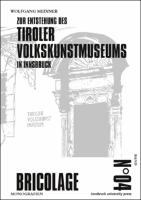Zur Entstehung des Tiroler Volkskunstmuseums in Innsbruck
| dc.contributor.author | Meixner, Wolfgang | |
| dc.date.accessioned | 2021-01-22T15:34:11Z | |
| dc.date.available | 2021-01-22T15:34:11Z | |
| dc.date.issued | 2020 | |
| dc.identifier | ONIX_20210122_9783991060185_9 | |
| dc.identifier.uri | https://library.oapen.org/handle/20.500.12657/46246 | |
| dc.language | German | |
| dc.relation.ispartofseries | bricolage monografien | |
| dc.subject.classification | thema EDItEUR::N History and Archaeology::NH History::NHB General and world history | en_US |
| dc.subject.classification | thema EDItEUR::G Reference, Information and Interdisciplinary subjects::GL Library and information sciences / Museology::GLZ Museology and heritage studies | en_US |
| dc.subject.other | History | |
| dc.subject.other | Tyrol | |
| dc.subject.other | Geschichtswissenschaft | |
| dc.subject.other | Tirol | |
| dc.title | Zur Entstehung des Tiroler Volkskunstmuseums in Innsbruck | |
| dc.type | book | |
| oapen.abstract.otherlanguage | This book deals with the eventful history of the Tyrolean Folk Art Museum (Tiroler Volkskunstmuseum). After a long founding phase that goes back to the 1880s, discussions about its content and considerations about its location, the museum was opened in 1929 in the former Franciscan monastery in the center of Innsbruck. Its extensive folklore and cultural studies collection comes from the European region of Tyrol-South and Tyrol-Trentino. It stands in the field of tension between art, everyday culture, handicraft and mass production. While in the past the focus of the collection was on artistic, aesthetic, historical and aspects of exceptionality, since the redesign in 2008 the collection has been expanded to include the present and takes more everyday things into account. The volume contains an editorial note from the editors (Reinhard Bodner and Timo Heimerdinger), introductory remarks by the author on the recent history of research, a foreword by the chairwoman of the Friends of the Tyrolean Folk Art Museum (Freundeskreis des Tiroler Volkskunstmuseums), Herlinde Keuschnigg, and an epilogue by the current director of the museum, Mag. Dr . Karl C. Berger.; Dieses Buch behandelt die wechselvolle Geschichte des Tiroler Volkskunstmuseums. Nach einer langen Gründungsphase, die bis in die 1880er Jahre zurückreicht, Diskussionen um seine inhaltliche Ausrichtung sowie Überlegungen zum Standort wurde das Museum 1929 im ehemaligen Franziskanerkloster im Zentrum Innsbrucks eröffnet. Seine umfangreiche volkskundlich-kulturwissenschaftliche Sammlung stammt räumlich aus der Europaregion Tirol-Südtirol-Trentino. Sie steht im Spannungsfeld von Kunst, Alltagskultur, Handwerk und Massenproduktion. Während in der Vergangenheit kunsthandwerklich-ästhetische, historische und Gesichtspunkte der Außergewöhnlichkeit im Sammlungsfokus standen, wird die Sammlung seit der Neugestaltung 2008 verstärkt zur Gegenwart ausgebaut und berücksichtigt mehr das Alltägliche. Der Band enthält eine editorische Notiz der Herausgeber (Reinhard Bodner und Timo Heimerdinger), einleitende Bemerkungen des Verfassers zur jüngeren Forschungsgeschichte, ein Geleitwort der Obfrau des Freundeskreises des Tiroler Volkskunstmuseums, Herlinde Keuschnigg, sowie ein Nachwort des jetzigen Leiters des Museums, Mag. Dr. Karl C. Berger. | |
| oapen.identifier.doi | 10.15203/99106-018-5 | |
| oapen.relation.isPublishedBy | 7e4aa047-ebd5-4269-b6c8-a86925324b93 | |
| oapen.collection | AG Universitätsverlage | |
| oapen.series.number | 4 | |
| oapen.pages | 272 | |
| oapen.place.publication | Innsbruck |

